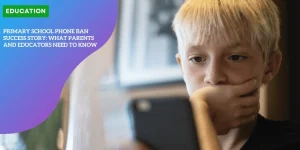Digital Detox in Schools: Inside Hitchin’s Groundbreaking Year 9 Smartphone Policy
The Genesis of Hitchin’s Digital Revolution
William Ransom Primary School’s Pioneering Initiative
At the heart of Hitchin’s digital detox initiative lies William Ransom Primary School, leading an ambitious campaign aimed at delaying children’s smartphone access until Year 9.
This groundbreaking endeavor seeks to foster healthier childhood development by reducing early exposure to digital distractions.
The school’s commitment is evident in its push for parental pledges to postpone smartphone usage until students are adequately mature.
Parent Richard Bowdler’s Role in Initiating the Movement
The movement’s inception can be traced back to Richard Bowdler, a concerned parent who observed the detrimental impact of early smartphone use.
In February, Bowdler, along with a group of like-minded parents, recognized that smartphones were increasingly becoming a norm for children entering secondary school.
Concerned about the possible consequences for their kids’ social and mental well-being, they collectively decided to take action.
Bowdler’s proposal, though unconventional, found a receptive audience in Mr.
Tony Plunkett, the head teacher of William Ransom Primary School.
Plunkett saw the potential benefits of the initiative, understanding the importance of developing strong face-to-face communication skills before introducing digital distractions.
His endorsement was a turning point for the group, providing the momentum needed to turn their concerns into a community-wide movement.
Head Teacher Tony Plunkett’s Endorsement and Vision for Community-Wide Implementation
Tony Plunkett has been instrumental in championing this cause, providing the necessary institutional support and vision.
“Creating a community where more children are without smartphones than with them makes it easier for parents to maintain the pledge,” Plunkett emphasized.
His vision extends beyond William Ransom Primary School, aiming to engage all 25 primary schools in Hitchin in a united front against early smartphone use.
The endorsement from Plunkett lent credibility to the movement, encouraging more parents to join and take a stand.
Community meetings were organized, and discussions facilitated, fostering a culture of collective action and mutual support among parents.
As the movement gained traction, the aim was clear: create a supportive, community-driven environment where delaying smartphone access until Year 9 becomes the norm.
Through this structured approach, Hitchin is setting a precedent, demonstrating that collective efforts can pave the way for more meaningful, healthier childhoods.

Understanding the Need for Digital Detox
Increased Anxiety Linked to Problematic Smartphone Use
Research has consistently shown a connection between problematic smartphone use and heightened levels of anxiety in teenagers. This phenomenon is associated with several aspects of smartphone dependency:
- Constant need for digital connection
- Regular exposure to online conflicts
- The pressure of maintaining a digital presence
These elements create a perfect storm for mental health issues among teens.
The Hitchin initiative aims to mitigate these problems by delaying smartphone accessibility until Year 9, giving children a chance to develop solid coping mechanisms and balanced digital habits.
Alarming Statistics on Cyberbullying
A staggering 84% of bullying incidents among children aged 8 to 17 happen via smartphones.
The digital realm, while offering numerous benefits, can also be a breeding ground for hostile and harmful interactions.
By postponing access to smartphones, the Hitchin initiative aims to significantly reduce the instances of cyberbullying, thereby protecting young minds from long-lasting adverse effects.
Impact of Early Smartphone Use on Face-to-Face Communication Skills
One of the core objectives of the Hitchin initiative is to nurture effective face-to-face communication skills.
Early exposure to smartphones often results in an over-reliance on text-based communication.
This form of interaction lacks the emotional nuance and context provided by real-world social cues, leading to:
- Increased misunderstandings
- Greater potential for conflicts
- Reduced face-to-face interaction skills
By delaying smartphone usage, children are encouraged to master the art of real-world social interactions, building a solid foundation for their future personal and professional lives.
These aspects emphasize the critical need for a digital detox among young children.
As the community of Hitchin comes together to support this initiative, the focus shifts towards the community-driven approach to making this vision a reality.
The Community-Driven Approach
Parent Pledge System and Commitment
Central to Hitchin’s initiative is the parent pledge system, where families commit to delaying their children’s smartphone access until Year 9.
This pledge, driven by a collective understanding of the potential harms of early smartphone use, fosters a supportive environment among parents.
By affirming this commitment, parents are empowered to resist societal pressures and prioritize their children’s social and emotional health.
Expansion Goals to Include All 25 Primary Schools in Hitchin
Encouragingly, William Ransom Primary School’s campaign is not an isolated endeavor.
The aim is to extend the initiative to all 25 primary schools in Hitchin.
Head teacher Tony Plunkett envisions a community where limiting early smartphone use is a norm across all primary schools.
Unified in goal and action, this broader adoption will create a more consistent and supportive environment for all children in Hitchin.
Creation of Support Networks and Chat Groups for Parents
To ensure the success of this initiative, establishing strong support networks is essential.
Parents have formed various chat groups and support systems to share experiences, concerns, and strategies.
For instance, WhatsApp groups serve as platforms for constant communication, offering tips on maintaining smartphone boundaries and insights on alternative activities.
Regular meetings and online discussions help in collective problem-solving and provide a sense of community, making it easier to adhere to the pledge.
A testament to the initiative’s effectiveness, these parent-driven support networks have fostered an invaluable resource.
They encourage shared purpose and empower parents to maintain their commitment against the societal push for early smartphone access.
With a collaborative and community-driven approach, the Hitchin initiative is setting a precedent for fostering healthier childhood experiences by emphasizing real-world interactions over digital engagement.
This collective action not only supports immediate goals but also lays a strong foundation for future expansion and broader community acceptance.
Student Perspectives and Experiences
Contrasting Views from Year 6 Students
When discussing Hitchin’s initiative, Year 6 students have varied perspectives.
Amelie finds smartphone use practical for safety and sociality.
“I use it to text my parents so I can go to the local shop safely, but I also use it to chat with my friends,” she says.
Her father was initially hesitant but eventually agreed, provided she uses it in moderation.
Conversely, Luke does not have a smartphone and sees no rush to get one.
His 15-year-old brother’s distraction by his phone during activities like sports makes him wary.
“I’d rather enjoy doing things without it,” he asserts.
Balancing Safety Concerns with Social Connectivity
For students like Amelie and their parents, safety is a significant concern.
Smartphones can offer a sense of security by keeping children in touch with their parents.
However, this concern must be balanced with the risks associated with early and excessive smartphone use.
Many parents in the Hitchin initiative have creatively found ways to ensure their children’s safety without fully relying on smartphones.
Some opt for simpler communication devices that allow emergency contact without the distracting features of a smartphone.
Student Awareness of the Drawbacks of Excessive Phone Use
Many Year 6 students are aware of the pitfalls of excessive smartphone use.
Amelie stresses the need for balance, acknowledging how screen time should not overshadow real-life activities.
Luke, too, highlights the importance of engaging in face-to-face interactions and outdoor activities, recognizing how his brother’s excessive phone use impacts quality time and physical activities.
This growing awareness among children about the balance between digital and real-life experiences signifies a critical shift.
Encouraging such self-awareness is essential for fostering healthier digital habits and developing skills for real-world interactions.
As Hitchin’s community-driven approach continues to resonate with students and parents alike, the initiative’s long-term impact promises a more focused and socially adept younger generation.
Implementation Strategies and Support Systems
Alternative Communication Devices and Clear Usage Rules
To address safety concerns without succumbing to full smartphone usage, parents and schools in Hitchin are exploring a range of alternative communication devices.
These simpler devices, designed primarily for calling and texting, ensure that children can stay in touch with their parents in case of emergencies.
Devices like these offer a middle ground, providing safety without the risks of social media or internet-based distractions.
Parents are also setting clear, consistent rules about device usage from an early age.
By establishing these guidelines, expectations are well understood, and children learn the value of moderation.
Rules might include device-free family times or specific hours when devices are allowed.
This approach helps children habitually regulate their screen time in a controlled manner, fostering a healthier relationship with technology.
School-Organized Activities Promoting Real-World Interactions
William Ransom Primary School and other participating schools are actively organizing various activities to keep children engaged in the physical world.
These activities range from sports events to arts and crafts, encouraging students to interact and collaborate face-to-face.
Regular extracurricular programs help build social skills, teamwork, and empathy among students, creating a strong foundation for their social and emotional development.
Regular community and family-oriented events also play a crucial role.
These gatherings provide opportunities for parents and children to connect without digital interference, reinforcing the importance of real-world interactions.
By making these events a staple of the school calendar, schools ensure that children have ample opportunity to engage with their peers and environment.
Parent Support Networks for Sharing Experiences and Strategies
A key element of the initiative’s success is the robust parent support networks that have taken shape.
These networks, often facilitated through chat groups or regular meet-ups, allow parents to share experiences, challenges, and successes.
Platforms like WhatsApp have been instrumental in connecting parents, enabling them to offer support and advice on maintaining smartphone boundaries and resisting societal pressures.
These support networks provide a sense of community and shared purpose.
Parents exchange tips on alternative activities to keep children engaged and share strategies for handling the inevitable pressures of digital connectivity.
Regular meetings and online discussions foster a collective resolve, making it easier for parents to stay committed to the initiative.
Hitchin’s approach of combining alternative communication methods, school-organized activities, and strong parental networks creates a solid framework for success.
These supportive measures not only help in delaying smartphone access but also lay the groundwork for children’s broader developmental benefits.
Impact and Future Outlook
Observed Improvements in Social Skills and Classroom Focus
The Hitchin initiative to delay smartphone access until Year 9 has shown promising results in a relatively short span.
Teachers at William Ransom Primary School have noticed significant strides in students’ social skills and peer interactions.
Without the lure of smartphones, children are engaging more in face-to-face conversations and collaborative activities.
This shift has fostered a more inclusive and interactive classroom environment.
Additionally, the absence of digital distractions has led to better classroom focus.
Students who are not preoccupied with their phones are more attentive and participative in lessons.
This has resulted in an overall improvement in academic performance and classroom dynamics, aligning with the initiative’s goals.
Potential for Expansion Beyond Hitchin
The success of the Hitchin initiative hasn’t gone unnoticed.
Parents and educators in other regions are showing interest in adopting this model.
Plans to extend this policy to all 25 primary schools in Hitchin are already underway, with promising prospects for further expansion.
The Suffolk initiative led by Daisy Greenwell stands as a testament to the viability of community-driven efforts to delay smartphone access.
Such initiatives underscore the effectiveness of collective action in fostering healthier childhood development.
The Hitchin model can serve as a blueprint for communities across the country, enhancing its reach and impact.
Long-Term Benefits for Children’s Social and Emotional Development
The long-term benefits of delaying smartphone use until Year 9 are manifold.
Firstly, children develop stronger face-to-face communication skills.
This foundation is crucial for building deeper, more meaningful relationships.
By engaging more in real-world interactions, children also enhance their emotional intelligence, learning to read social cues and handle conflicts more effectively.
Furthermore, reducing early exposure to smartphones can mitigate the risks of anxiety and cyberbullying.
With fewer digital stressors, children can enjoy a safer and more relaxed growth environment.
This approach not only supports immediate well-being but also lays the groundwork for children to grow into well-rounded, emotionally resilient adults.
The Hitchin initiative is not just about limiting screen time; it’s about creating a supportive community that prioritizes healthy development over digital pressures.
As more communities adopt this model, the journey towards fostering a balanced relationship with technology for future generations will continue to make strides.






